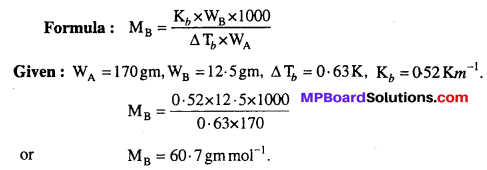MP Board Class 12th Chemistry Solutions Chapter 2 Solutions
Solutions NCERT Intext Exercises
Question 1.
Calculate the mass percentage of benzene (C6H6) and carbon tetrachloride (CCl4) if 22 g of benzene is dissolved in 122 g of carbon tetrachloride.
Solution:
Mass of solution = Mass of benzene + Mass of CCl4
= 22g + 122g = 144g
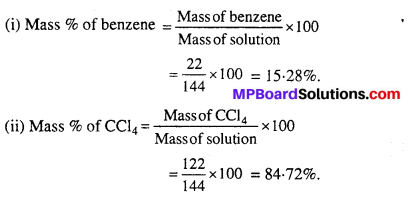
Alternatively : Mass % of CC14 = 100 – 15.28 = 84.72%.
Question 2.
Calculate the mole fraction of benzene in solution containing 30% by mass in carbon tetrachloride.
Solution:
30% of benzene in carbon tetrachloride by mass means that
Mass of benzene in the solution = 30 g
Mass of solution = 100 g
∴ Mass of carbon tetrachloride = 100 – 30 g = 70 g
Molar mass of benzene (C6H6) = 78 g mol-1
Molar mass of CCl4 = 12 + 4 × 35.5 = 154 g mol-1
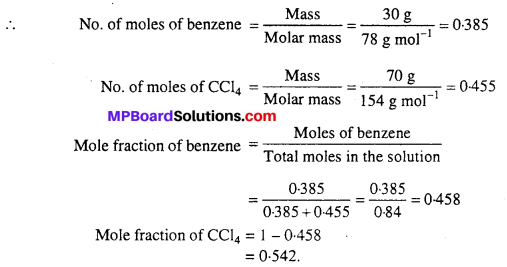
Question 3.
Calculate the molarity of each of the following solutions:
(a) 30 g of Co(NO3)2. 6H2O in 4-3 L of solution
(b) 30 ml of 0.5 M H2SO4 diluted to 500 ml.
Solution:
(a) Molar mass of Co(NO3)2.6H2O = MB = 291, WB of Co(NO3)2.6H2O = 30g, Vsol = 4.3L = 4300ml
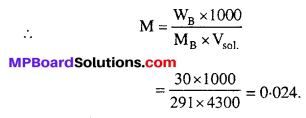
(b) Molanty of solution after dilution may be calculated as.
M1V1 (Concentrated) M2,V2 (Diluted)
0.5 x 30 = M2 x 500
M2 = \(\frac{0 \cdot 5 \times 30}{500}\) = 0.03
Question 4.
Calculate the mass of urea (NH2CONH2) required in making 2.5 kg of 0.25 molal aqueous solution.
Solution:
0-25 molal aqueous solution means that
Moles of urea = 0.25 mole
Mass of solvent (water) = 1 kg = 1000 g
Molar mass of urea = 14 + 2 + 12 + 16 + 14 + 2 = 60g mol-1
∴ 0.25 mole of urea = 60 × 0.25 mole = 15 g
Total mass of the solution = 1000 + 15 g
= 1015 g = 1.015 g
∵ 1.015 kg of solution contain urea = 15 g
∴ 2.5 kg of solution will require urea = \(\frac { 15 }{ 1.015 } \) × 2.5 kg = 37g .
Question 5.
Calculate (a) molality (b) molarity and (c) mole fraction of KI if the density of 20% (mass/mass) aqueous KI is 1.202 g ml-1.
Solution:
Here, MB = 166, WB = 20, WA = 80
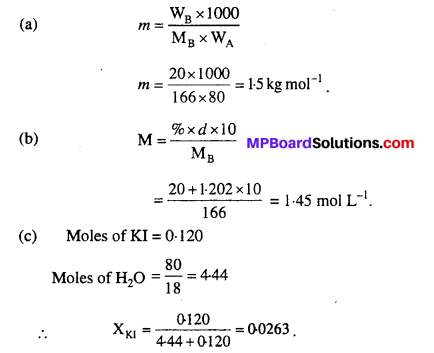
Question 6.
H2S, a toxic gas with rotten egg like smell, is used for the qualitative analysis. If the solubility of H2S in water at STP is 0.195 m, calculate Henry’s law constant
Solution:
0.195m solution means that 0.195 moles of H2S is dissolved in 1 kg of water.
Moles of H2S = 0.195
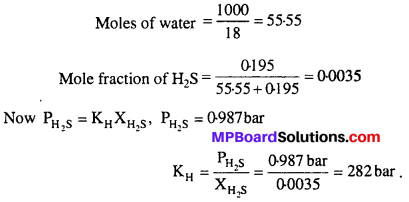
Question 7.
Henry’s law constant for CO2 in water is 1.67 × 108 Pa at 298 K. Calculate the quantity of CO2 in 500 ml of soda water when packed under 2.5 atm CO2 pressure at 298 K.
Solution:
According to Henry’s law
P = KHX …(1)
P = 2.5 atm = 2.5 × 101325 Pa, KH = 1.67 × 108 Pa
Putting these values in equation (1), we get
2.5 × 101325 = 1.67 × 108 × XCO2
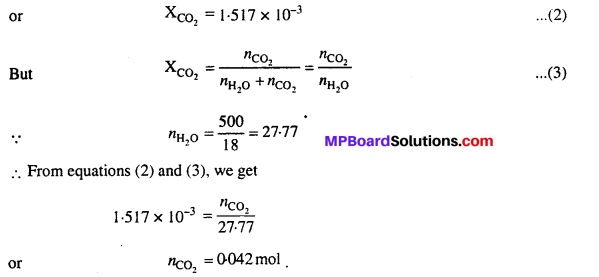
![]()
Question 8.
The vapour pressure of pure liquids A and B are 450 and 700 mm Hg respectively, at 350 K. Find out the composition of the liquid mixture if total vapour pressure is 600 mm Hg. Also And the composition of the vapour phase.
Solution:
Here, P°A = 450 mm, P°B = 700 mm, PTotal = 600 mm
Applying Raoult’s law
PA = XAP°A, PB = XBP°B = (1 – XA)P°B
PTotal = PA + PB = XAP°A + (1 – XA)P°B =
P°B + (P°A – P°B) XA.
Substituting the value we get
600 = 700+ (450 – 700) XA
or 250 XA = 100
or XA = \(\frac { 100 }{ 250 } \) = 0.40
Thus, the composition of the liquid mixture will be
XA (mole fraction of A) = 0.40
XB (mole fraction of B) = 1 – 0.40 = 0.60
∴ PA = XAP°A = 0.40 × 450 = 180 mm
PB = XBP°B = 0.60 × 700 = 420 mm
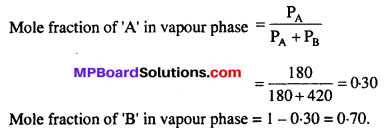
Question 9.
Vapour pressure of pure water at 298 K is 23.8 mm Hg. 50 g of urea (NH2CONH2) is dissolved in 850 g of water. Calculate the vapour pressure of water for this solution and its relative lowering.
Solution:
We know that

Here, P° = 23-8mm, W2 = 50g, M2(urea) = 60 g mol-1, W1 = 850g, M1 (water) = 18 g mol-1
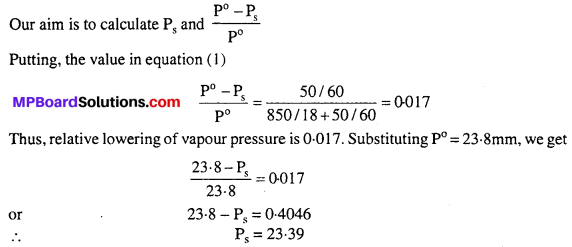
Thus, vapour pressure of water in the solution = 23.4 mm.
Question 10.
Boiling point of water at 750 mm Hg is 99.63°C. How much sucrose is to be added to 500 g of water such that it boils at 100°C. Molal elevation constant for water is 0.52 K kg mol-1.
Solution:
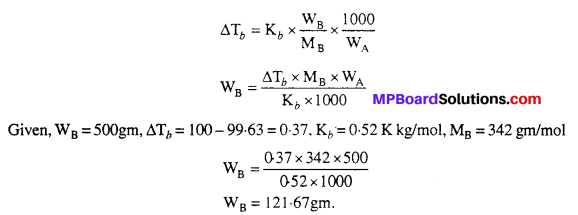
Question 11.
Calculate the mass of ascorbic acid (Vitamin C, C6H8O6) to be dissolved in 75 g of acetic acid to lower its melting point by 1.5°C. KF = 3.9 K kg mol-1.
Solution:
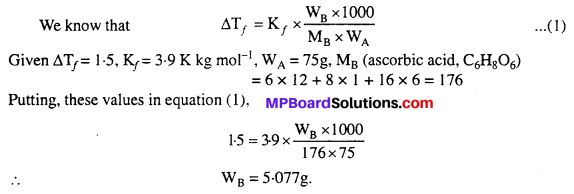
Question 12.
Calculate the osmotic pressure in pascals exerted by a solution prepared by dissolving 1.0 g of poly-mer of molar mass 1,85,000 in 450 ml of water at 37°C.
Solution:
π = CRT
\(=\frac{n}{\mathrm{V}} \mathrm{RT}\)
Here, number of moles of solute dissolved (n) =
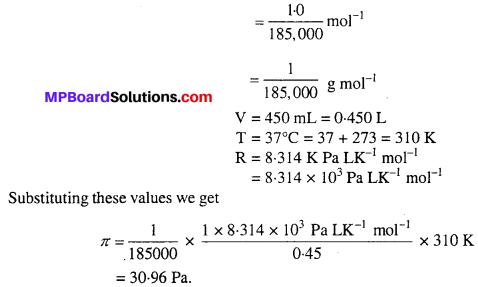
![]()
Solutions NCERT TextBook Exercises
Question 1.
Define the term solution. How many types of solutions are formed ? Write briefly about each type with an example.
Answer:
A solution is a homogeneous mixture of two or more substances which are chemically non-reacting. On the basis of physical component solutions are of the following types :
Solid Solution

Liquid Solution

Gaseous Solution

Question 2.
Suppose a solid solution is formed between two substances, one whose particles are very large and the other whose particles are very small. What kind of solid solution is this likely to be ?
Answer:
Interstitial solid solution.
Question 3.
Define the following terms :
(i) Mole fraction
(ii) Molality
(iii) Molarity
(iv) Mass percentage.
Answer:
(i) Mole fraction : Ratio of moles of a component (solute or solvent) to the total number of moles of all the components of solution is called mole fraction. If moles of solute is n and that of solvent is N, then
Mole fraction of solute = \(\frac { n }{ n+N } \)
and mole fraction of solvent = \(\frac { N }{ n+N } \)
(ii) Molality: Molality is defined as number of moles of solute present in a kilogram (1000 gram) of solvent. It is denoted by m.

(iii) Molarity : Molarity is defined as number of gram moles of solute dissolved in a litre of solution. It is denoted by M.

(iv) Mass percentage: The mass percentage of a component in a given solution is the mass of the component per 100 gm of the solution.

This can be expressed as WAV. For example, 10% Na2CO3 WAV means 10g of Na2CO3 is dissolved in 100 g of the solution (It means 10 g Na2CO3 is dissolved in 90 g of H2O).
Question 4.
Concentrated nitric acid used in laboratory work is 68% nitric acid by mass in aqueous solution. What should be the molarity of such a sample of the acid if the density of the solution is 1-504 g ml-1 ?
Solution:
68% nitric acid by mass means that
Mass of nitric acid = 68 g
Mass of solution = 100 g
Molar mass of HNO3 = 63 g mol-1


Question 5.
A solution of glucose in water is labelled as 10% WAV, what would be the molality and mole fraction of each component in the solution ? If the density of solution is 1.2 g ml-1, then what shall be the molarity of the solution ?
Solution:
10% (W/W) glucose means 10g of glucose in 100g of solution i.e., 90 g of water = 0.090 kg of water
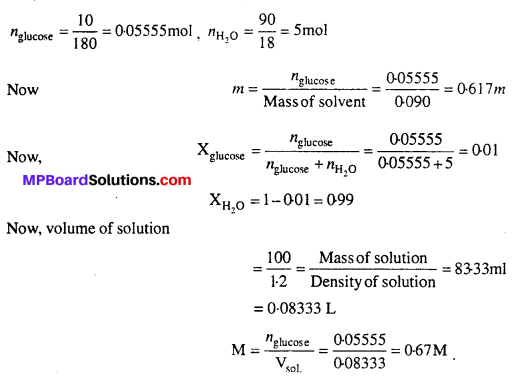
Question 6.
How many ml of 0.1M HCl are required to react completely with lg mixture of Na2CO3 and NaHCO3 containing equimolar amount of both ?
Solution:
Let there, is x g Na2CO3 and (1 – x)g NaHCO3 in the mixture.
Molar mass of Na2CO3 = 106 g/mol
Molar mass of NaHCO3 = 84 g/mol
Number of moles of Na2CO3 = Number of moles of NaHCO3
\(\frac { x }{ 106 } \) = \(\frac { (1-x) }{ 84 } \)
On solving, x = 0.56.
Number of moles of Na2CO3 = Number of moles of NaHCO3 = 5.283 × 10-3
During the process of Neutralisation, following reactions takes place :
Na2CO3 + 2HCl → 2NaCl + H2O + CO2 ↑
NaHCO3 + HC1 → NaCl + H2O + CO2 ↑
Number of moles of HCl required = 2 × Number of moles of Na2CO3 + Number of moles of NaHCO3
= 2 × 5.283 × 10-3 + 5.283 × 10-3 = 0.0158

Question 7.
A solution is obtained by mixing 300 g of 25% solution and 400g of 40% solution by mass. Calculate the mass percentage of the resulting solution.
Solution:
300 g of 25% solution contain solute = 75g
400g of 40% solution contain solute = 160g
Total solute = 160 + 75 = 235g
Total solution = 300 + 400 = 700g
∴ Mass % of solute = \(\frac { 235 }{ 700 } \) × 100 = 33.5%
and mass % of water = 100 – 33.5 = 66.5%.
Question 8.
An antifreeze solution is prepared from 222.6 g of ethylene glycol (C2H6O2) and 200 g of water. Calculate the molality of the solution. If the density of the solution is 1-072 g ml-1, then what shall be the molarity of the solution ?
Solution:
Mass of solute, C2H4(OH)2 = 222.6g, Molar mass of solute = 62 g mol-1
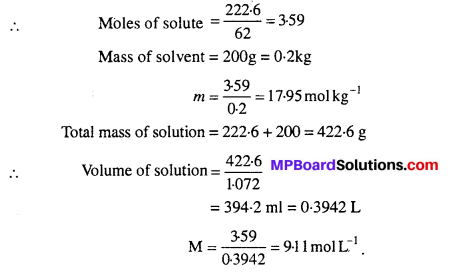
Question 9.
A sample of drinking water was found to be severely contaminated with chloroform (CHCl3) supposed to be a carcinogen. The level of contamination was 15 ppm (by mass):
(i) express this in percent by mass
(ii) determine the molality of chloroform in the water sample.
Solution:
15 ppm (by mass) means 15 g of CHCl3 is present in 106 g of solution.
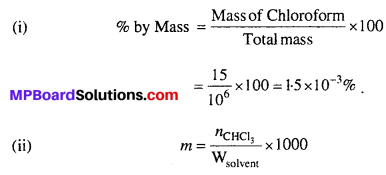
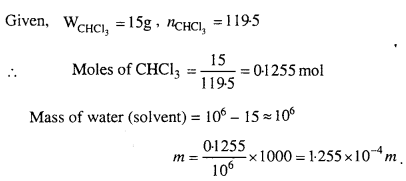
Question 10.
What role does the molecular interaction play in a solution of alcohol and water ?
Answer:
Alcohols dissolve in water due to formation of inter-molecular H-bonding with water.
Question 11.
Why do gases always tend to be less soluble in liquids as the temperature is raised ?
Answer:
![]()
The dissolution of a gas in a liquid is exothermic process. Therefore in accordance with Le-Chatilier’s principle with increase in temperature, the equilibrium shifts in back¬ward direction. Therefore, the solubility of gas in solution decreases with the rise in temperature.
Question 12.
State Henry’s law and mention some important applications.
Answer:
Henry’s law : According to this law, ‘The mass of a gas dissolved per unit volume of a solvent at constant temperature, is proportional to the pressure of the gas with which the solvent is in equilibrium’.
Let in unit volume of solvent, mass of the gas dissolved is m and equilibrium pressure be P, then m α P or m = KP, where K is a constant.
We can understand Henry’s law by taking example of soda water bottle. Soda water contains carbon dioxide dissolved in water under pressure.
Applications of Henry’s law :
1. In the production of carbonated beverages : To increase the solubility of CO2 in soft drinks, soda water, bear etc. the bottles are sealed at high pressure.
2. In exchange of gases in the blood : The partial pressure of O2 is high inhaled air, in lungs it combines with haemoglobin to form oxyhaemoglobin. In tissues, the partial pressure of oxygen is comparatively low therefore oxyhaemoglobin releases oxygen in order to carry out cellular activities.
3. In deep sea diving : Deep sea divers depend upon compressed air for breathing at high pressure under water. The compressed air contains N2 in addition to O2, which are not very soluble in blood at normal pressure. However, at great depths when the diver breathes in compressed air from the supply tank, more N2 dissolve in the blood and in other body fluids because the pressure at that depth is far greater than the surface atmospheric pressure. When the divers come towards the surface at atmospheric pressure, this dissolve nitrogen bubbles out of the blood. These bubbles restrict blood flow, affect the transmission of nerve impulses. This causes a disease called bends or decompression sickness. To avoid bends, as well as toxic effects of high concentration of nitrogen in blood, the tanks used by scuba divers are filled with air diluted with helium (11.7% He, 56.2% N2 and 32.1% O2).
4. At high altitudes: At high altitudes the partial pressure of O2 is less than that at the ground level. This result in low concentration of oxygen in the blood and tissues of the people living at high altitudes or climbers. The low blood oxygen causes climbers to become weak and unable to think clearly known as anoxia.
5. Aquatic life : The dissolution of oxygen (from air) in water helps in the existence of aquatic life in various water bodies like : Lake, rivers and sea.
Question 13.
The partial pressure of ethane over a solution containing 6.56 x 10-3 g of ethane is 1 bar. If the solution contains 5.00 x 10-2 g of ethane, then what shall be the partial pressure of the gas ?
Solution:
According to Henry’s law m = KP, 6.56 × 10-3 g = K × 1 bar, K = 6.56 × 10-3 g bar-1
Now when m = 5 × 10-2 g, P = ?
Applying m’ = K × P
5.00 × 10-2g = 6.56 × 10-3 g bar-1 × P

Question 14.
What is meant by positive and negative deviations from Raoult’s law and how is the sign of ∆mix H related to positive and negative deviations from Raoult’s law ?
Answer:
Positive deviation : When vapour pressure of the solution is greater than as expected on the basis of Raoult’s Law, it is known as positive deviation. For a solution formed by components A and B, if the A-B interactions in the solutions are weaker than the solute A-A and solvent B-B interactions in the two components, then the escaping tendency of A and B types of molecules from the solution becomes more than from pure liquids. As a result, each component of the solution has a partial vapour pressure greater than expected on the basis of Raoult’s Law.
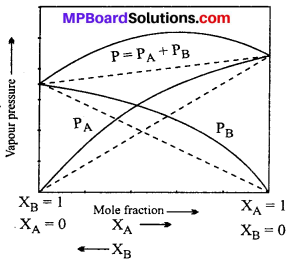
Characteristics of solution representing positive deviation if:

Example: (1) Ethyl alcohol and water
(2) Acetone and benzene.
Negative deviation: When vapour pressure of the solution is less than as expected on the basis of Raoult’s Law, it is known as negative deviation. In this type of solution, A-B (solute- solvent) interaction is stronger than the interaction between A-A (solute-solute) and B-B (solvent-solvent). Thus, the escaping tendency of A and B types of molecules from the solution becomes less than from pure liquids. As a result, each component of the solution has a partial vapour pressure lesser than expected on the basis of Raoult’s Law.
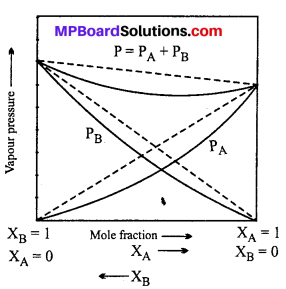
Characteristics of solution representing negative deviation.if:

Example : (1) HNO2 and water and
(2) Chloroform and Acetone.
![]()
Question 15.
An aqueous solution of 2% non-volatile solute exerts a pressure of 1-004 bar at the normal boiling point of the solvent. What is the molar mass of the solute ?
Solution:
Vapour pressure of pure water at the boiling point
P° = 1 atm = 1.013 bar
Vapour pressure of solution Ps = 1.004 bar
M1 = 18 g mol-1
M2 = ?
Mass of solute = W2 = 2 g
Mass of solution = 100 g
Mass of solvent W1 = 98 g
Applying Raoult’s law for dilute solution
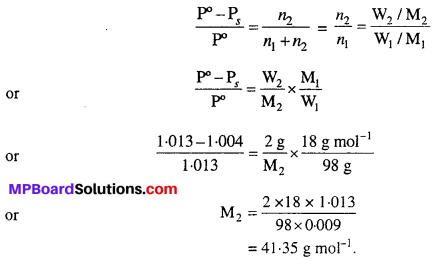
Question 16.
Heptane and octane form an ideal solution. At 373K, the vapour pressures of the two liquid components are 105.2 kPa and 46.8 kPa respectively. What will be the vapour pressure of a mixture of 26.0 g of heptane and 35 g of octane ?
Solution:
Heptane (C7H16) Octane (C8 H18)
Mass = 26g Mass = 35g
Molar mass = 100 Molar mass =114
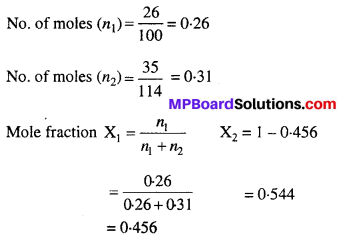

Question 17.
The vapour pressure of water is 12.3 kPa at 300K. Calculate vapour pressure of 1 molal solution of a non-volatile solute in it.
Solution:
1 molal solution means 1 mol of the solute in 1 kg of the solvent (water)
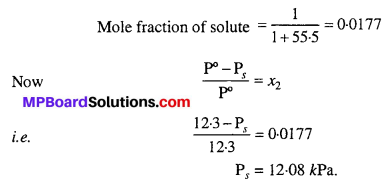
Question 18.
Calculate the mass of a non-volatile solute (molar mass 40 g mol-1) which should be dissolved in 114 g octane to reduce its vapour pressure to 80%.
Solution:
According to Raoult’s law, P = P°A XA …(1)
P° = 100 then P = 80
∴ From equation (1), XA = 0.80
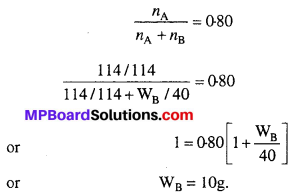
Question 19.
A solution containing 30 g of non-volatile solute exactly in 90 g of water has a vapour pressure of 2-8 kPa at 298 K. Further, 18 g of water is then added to the solution and the new vapour pressure becomes 2.9 kPa at 298 K. Calculate :
(i) molar mass of the solute
(ii) vapour pressure of water at 298 K.
Solution:
Applying the Raoult’s law
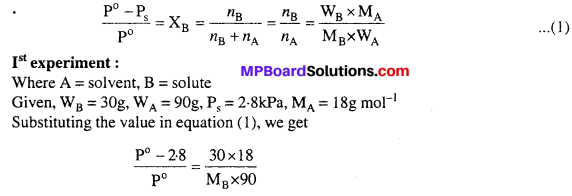

IInd experiment:
Given, WB = 30g, WA = 90 + 18 = 108g, Ps = 2.9 kPa, MA = 18 g mol2-1
Substituting the value in equation (1)
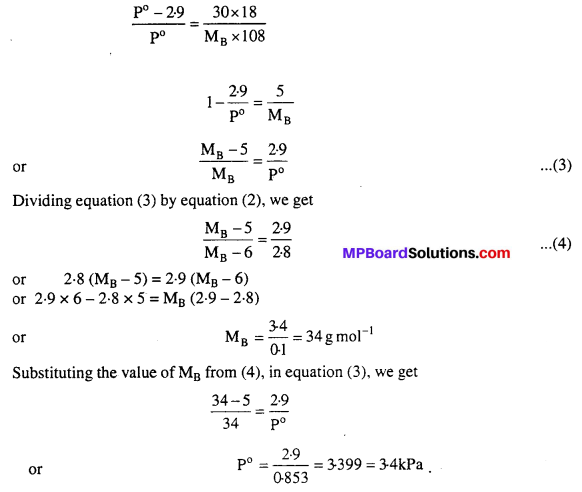
Question 20.
A 5% solution (by mass) of cane sugar in water has freezing point of 271 K. Calculate the freezing point of 5% glucose in water if freezing point of pure water is 273.15 K.
Solution:
For cane sugar, ∆Tf = 273.15 – 271.0 = 2.15°C

![]()
Question 21.
Two elements A and B form compounds having formula AB2 and AB4. When dissolved in 20g of benzene (C6H6), lg of AB2 lowers the freezing point by 2-3 Kwhereas 1.0g of AB4 lowers it by 1.3 K. The molar depression constant for benzene is 5.1 K kg mol-1. Calculate atomic masses of A and B.
Solution:
Applying the formula
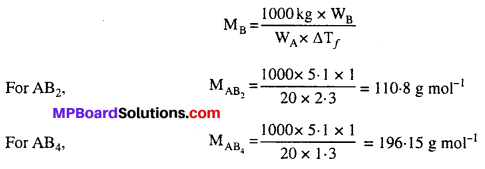
Suppose atomic masses of A and B are ‘a’ and ‘b’ respectively.
Then,
Molar mass of AB2 = a + 2b = 110.87 g mol-1 …(1)
Molar mass of AB4 = a + 4b = 196.15 g mol-1 …(2)
Equation (2) – (1) gives
2b = 85.28 or b = 42.64
Substituting in equation (1), we get
a + 2 × 42.64 = 110.87
or a = 25.59
Thus, atomic mass of A = 25.59 u
Atomic mass of B = 42.64u.
Question 22.
At 300 K, 36g of glucose present in a litre of its solution has an osmotic pressure of 4.98 bar. If the osmotic pressure of the solution is 1.52 bars at the same temperature, what would be its concentration ?
Solution:

Dividing equation (1) by equation (2), we get

Here, the volume of solution is 1L. So, the conc, of the solution

Question 23.
Suggest the most important type of intermolecular attractive interaction in the following pairs :
(i) n-hexane and n-octane
(ii) I2 and CCl4
(iii) NaClO4 and water
(iv) methanol and acetone
(v) acetonitrile (CH3CN) and acetone (C3H6O).
Answer:
(i) n-hexane and n-octane : Dispersion or London force.
(ii) I2 and CCl4 (Both non-polar): London or Dispersion force.
(iii) NaClO4 (Ionic) and water (Polar): Ion-dipole interaction also called hydration of ion.
(iv) Methanol (Polar) and acetone (Polar): Dipole-dipole interaction.
(v) Acetonitrile (Polar) and acetone (Polar): Dipole-dipole.
Question 24.
Based on solute-solvent interactions, arrange the following in order of increasing solubility in n-octane and explain :
Cyclohexane, KCl, CH3OH, CH3CN.
Answer:
For solubility we know ‘like dissolves like’, n-oc-tane is a non-polar solvent, hence non-polar compounds will be more soluble.
KCl < CH3OH < CH3CN < Cyclohexane.
Question 25.
Amongst the following compounds, identify which are insoluble, partially soluble and highly soluble in water :
(i) phenol
(ii) toluene
(iii) formic acid
(iv) ethylene glycol
(v) chloroform and
(vi) pentanol.
Answer:
Highly soluble : Formic acid and ethylene glycol. They are able to form H- bonding with water mole-cule.
Insoluble : Chloroform and toluene being non-polar are insoluble in polar medium like water.
Partially soluble : Phenol and pentanol form weaker H-bonding with water hence, they are partially soluble.
Question 26.
If the density of some lake water is T25 g ml-1 and contains 92 g of Na+ ions per kg of water, calculate the molality of Na+ ions in the lake.
Solution:
Given WB = 92g, MB = 23, WA = 1000g

Question 27.
If the solubility product of CuS is 6 × 10-16, calculate the maximum molarity of CuS in aqueous solution.
Solution:
Given Ksp of CuS = 6 × 10-16
If ‘s’ is the solubility, then
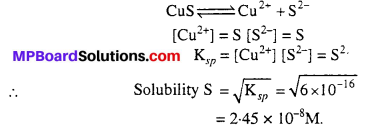
Question 28.
Calculate the mass percentage of aspirin (C9H8O4) in acetonitrile (CH3CN) when 6.5g of C9H8O4 is dissolved in 450g of CH3CN.
Solution:

Question 29.
Nalorphine (C19H21NO3), similar to morphine, is used to combat with drawal symptoms in narcotic users. Dose of nalorpheine generally given is 1.5 mg. Calculate the mass of 1.5 × 10-3 m aqueous solution required for the above dose.
Solution:

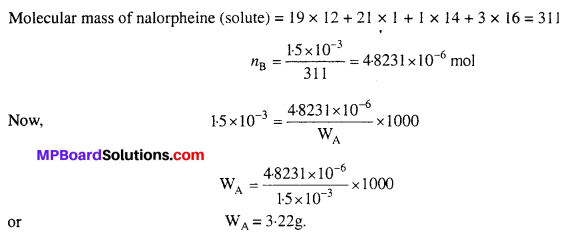
![]()
Question 30.
Calculate the amount of benzoic acid (C6H5CO-OH) required for preparing 250 ml of 0.15 M solution in methanol.
Solution:
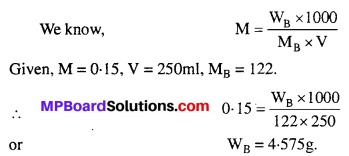
Question 31.
The depression in freezing point of water observed for the same amount of acetic acid, trichloroacetic acid and trifluoroacetic acid increases in the order given above. Explain briefly.
Answer:
Acetic acid < Trichloroacetic acid < Trifluoroacetic acid
Degree of ionisation, increases with the increase in the electron withdrawing effect of the groups attached to carboxylic group.
![]()
Increasing electron withdrawing effect
Depression in freezing point is a colligative property. As more ions are produced by ionisation of trifluoroacetic acid, so depression in freezing point is maximum.
Question 32.
Calculate the depression in the freezing point of water when 10 g of CH2CH2CHClCOOH is added to 250g of water. Ka = 1.4 × 10-3, Kf = 1.86 K kg mol-1.
Solution:
Molar mass of solute CH3CH2CHClCOOH (MB) = 122.5 g mol-1
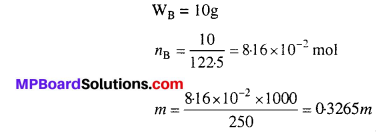
If α is the degree of dissociation of CH3CH2 CHCl-COOH.

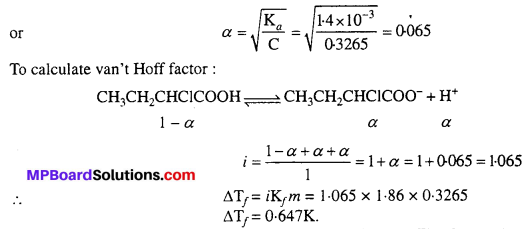
Question 33.
19-5g of CH2FCOOH is dissolved in 500g of water. The depression in the freezing point of water observed is 1-0°C. Calculate the van’t Hoff factor and disso-ciation constant of fluoroacetic acid.
Solution:
Molecular mass of CH2FCOOH (MB) = 78, WB = 19.5g, WA = 500g
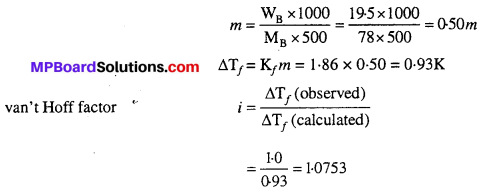
CH2FCOOH dissociates as CH2FCOO– and H+ if α is the degree of dissociation.
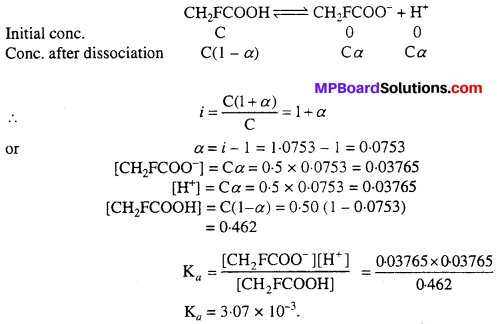
Question 34.
Vapour pressure of water at 293 K is 17.535 mm Hg. Calculate the vapour pressure of water at 293K when 25g of glucose is dissolved in 450g of water.
Solution:

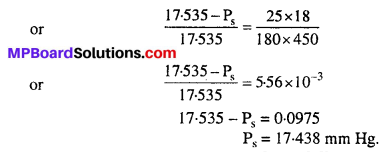
Question 35.
Henry’s law constant for the molality of methane in benzene at 298 K is 4.27 × 105 mm Hg. Calculate the solubility of methane in benzene at 298K under 760 mm Hg.
Solution:
Here KH = 4.27 × 105 mm, P = 760 mm
Applying Henry’s law, P = KHX

∴ Mole fraction of methane in benzene = 1.78 × 10-3.
Question 36.
100 g of liquid A (molar mass 140 g mol-1) was dissolved in 1000 g of liquid B (molar mass 180 g mol-1). The vapour pressure of pure liquid B was found to be 500 torr. Calculate the vapour pressure of pure liquid A and its vapour pressure in the solution if the total vapour pressure of the solution is 475 torr.
Solution:
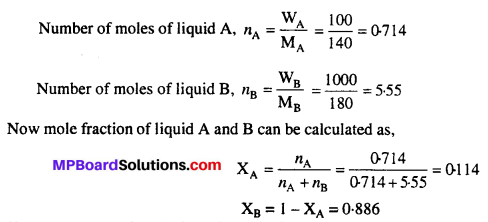
Vapour pressure of a solution of two liquids A and B may be calculated as

Question 37.
Vapour pressures of pure acetone and chloroform at 328K are 741.8 mm Hg and 632.8 mm Hg respectively. Assuming that they form ideal solution over the entire range of composition, plot Ptotal,Pchioroform and Pacetonc as a function of Xacetonc. The experimental data observed for different compositions of mixture is :

Plot this data also on the same graph paper. Indicate whether it has positive deviation or negative deviation from the ideal solution.
Answer:
From the question, we have the following data
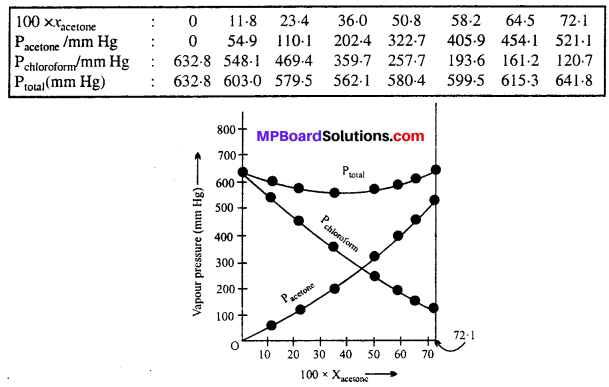
It can be observed from the graph that the plot for the Ptotal of the solution curves downwards. Therefore, the solution shows negative deviation from the ideal behaviour.
Question 38.
Benzene and toluene form ideal solution over the entire range of compo-sition. The vapour pressure of pure benzene and toluene at 300K are 50.71 mm Hg and 32.06 mm Hg respectively. Calculate the mole fraction of benzene in vapour phase if 80 g of benzene is mixed with 100 g of toluene.
Solution:
A → Benzene (C6H6); B → Toluene (C7Hg)
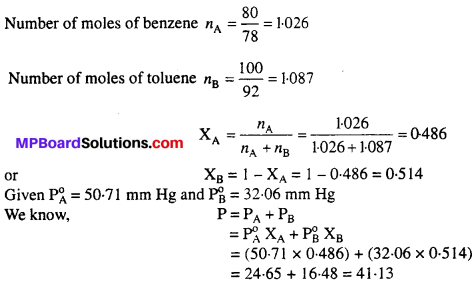
Mole fraction of components in vapour phase may be calculated by using Dalton’s law,

Question 39.
The air is a mixture of a number of gases. The major components are oxygen and nitrogen with approximate proportion of 20% is to 79% by volume at 298 K. The water is in equilibrium with air at a pressure of 10 atm. At 298 K if the Henry’s law constants for oxygen and nitrogen are 3.30 × 107 mm and 6.51 × 107 mm respectively, calculate the composition of these gases in water.
Solution:
The vapour pressure of air over water = 10 atm
The partial pressure of N2 and O2 are :
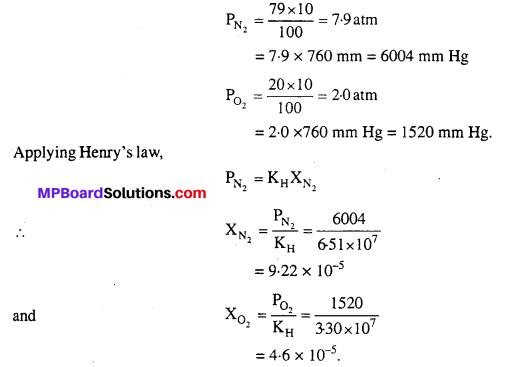
Question 40.
Determine the amount of CaCl2 (i = 2.47) dissolved in 2.5 litre of water such that its osmotic pressure is 0.75 atm at 27°C.
Solution:
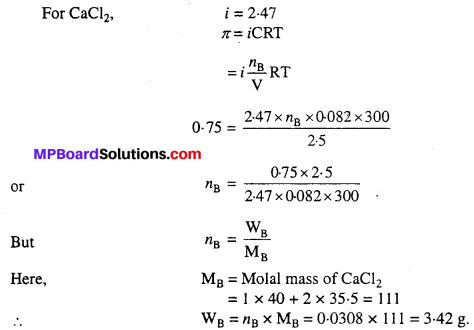
Question 41.
Determine the osmotic pressure of a solution prepared by dissolving 25 mg of K2SO4 in 2 litre of water at 25° C, assuming that it is completely dissociated.
Solution:

![]()
Solutions Other Important Questions and Answers
Solutions Objective Type Questions
Question 1.
Choose the correct answer :
Question 1.
The elevation in boiling point of a solution of molal concentration of solute will be maximum if the solvent is :
(a) Ethyl alcohol
(b) Acetone
(c) Benzene
(d) Chloroform.
Question 2.
Solutions of similar osmotic pressure are known as :
(a) Hypotonic
(b) Hypertonic
(c) Isotonic
(d) Normal.
Question 3.
How many ml of 1 M H2SO4 is required to neutralize 10 ml of 1 N NaOH :
(a) 20 ml
(b) 2.5 ml
(c) 5 ml
(d) 10ml.
Question 4.
Which of the following solution does not show positive deviation from Raoult’s law:
(a) Benzene – chloroform
(b) Benzene – acetone
(c) Benzene – ethanol
(d) Benzene – CCl4.
Question 5.
Molarity of solution of H2SO4 containing 9.8 gm H2SO4 dissolved in 2 litre water is:
(a) 0.1 M
(b) 0.05 M
(c) 0.01 M
(d) 0.2 M.
Question 6.
On dissolving common salt in water boiling point of water :
(a) Decreases
(b) Increases
(c) Does not change
(d) Cannot be said.
Question 7.
When blood cells are kept in high osmotic pressure solution than cellsap then:
(a) They contract
(b) They swell up
(c) Not affected
(d) First contract then swell.
Question 8.
All of the following form ideal solution, except one :
(a) C2H5Br and C2H5Cl
(b) C6H5Cl and C6H5Br
(c) C6H6 and C6H5CH3
(d) C2H5I and C2H5OH
Question 9.
According to Raoult’s law relative lowering of vapour pressure of solution of non-volatile solute is equal to :
(a) Mole fraction of solvent
(b) Mole fraction of solute
(c) Mass percent of solvent
(d) Mass percent of solute.
Question 10.
For osmotic pressure (P), volume (V) and temperature (T) which of the follow¬ing statement is false:
(a) P α \(\frac { 1 }{ V } \) T’s constant
(b) P α T if T is constant
(c) p α V if T is constant
(d) PV is constant if T is constant.
Question 11.
Whose boiling point is highest at 1 atm. pressure :
(a) 0.1M glucose
(b) 0.1M BaCl2
(c) 0.1M NaCl
(d) 0.1M urea.
Question 12.
Semipermeable membrane is chemically :
(a) Copper ferrocyanide
(b) Copper ferricyanide
(c) Copper sulphate
(d) Pottassium ferrocyanide.
Question 13.
Which among the following is a colligative property :
(a) Surface tension
(b) Viscosity
(c) Osmotic pressure
(d) Optical solution.
Question 14.
Experimental molecular mass of an electrolyte will ‘always be less than’ its calculated value because value of van’t Hoff factor i is :
(a) Less than 1
(b) More than 1
(c) Equal to 1
(d) Zero.
Question 15.
In molal solution, 1 mole of solute substance is dissolved in :
(a) In 1000 gm. solvent
(b) In 1 litre solution
(c) In 1 litre solvent
(d) In 224 litre solution.
Question 16.
If boiling point of solution is T1 and boiling point of solvent is T2, then elevation in boiling point will be :
(a) T1 + T2
(b) T1 – T2
(c) T2 – T1
(d) T1T2.
Question 17.
Colligative property is :
(a) Change in free energy
(b) Change in pressure
(c) Heat of vapourisation
(d) Osmotic pressure.
Question 18.
Gram molality of a solution is :
(a) Number of molecules of solute per 1000 ml solvent
(b) Number of molecules of solute per 1000 gm solvent
(c) Number of molecules of solute per 1000 ml solvent
(d) Number of gm equivalent of solute per 1000 ml solvent.
Question 19.
An Ideal solution is that:
(a) Which represents negative deviation towards Raoult’s law
(b) Which represents positive deviation towards Raoult’s law
(c) Is not related to Raoult’s law
(d) Obey’s Raoult’s law.
Question 20.
Order of osmotic pressure of BaCl2, NaCl and glucose solutions of same molarity will be:
(a) BaCl2 > NaCl > Glucose
(b) NaCl > BaCl2 > Glucose
(c) Glucose > BaCl2 > NaCl
(c) Glucose > NaCl > BaCl2.
Question 21.
A solution contains 20 mole solute and total number of moles is 80. Mole frac-tion of solute will be :
(a) 2.5
(b) 0.25
(c) 1
(d) 0.75.
Question 22.
A solution contain 1 mole of water and 4 moles of ethanol. The mole fraction of water and ethanol in solution will be :
(a) 0.2 water + 0.8 ethanol
(b) 0.4 water + 0.6 ethanol
(c) 0.6 water + 0.8 ethanol
(d) 0.8 water + 0.2 ethanol.
Question 23.
Colligative properties of solution depends upon :
(a) Nature of solvent
(b) Nature of solute
(c) Number of solute particles present in solution
(d) None of these.
Question 24.
Molality of pure water is :
(a) 55.6
(b) 50
(c) 100
(d) 18.
Question 25.
Is not a colligative property :
(a) Osmotic pressure
(b) Vapour pressure depression
(c) Freezing point depression
(d) Boiling point elevation.
Question 26.
Formula for determining osmotic pressure :

Question 27.
Ratio of observed value of colligative property to that of theoritical value is known as:
(a) Colligative property
(b) van’t Hoff factor
(c) Solution constant
(d) Specific constant.
Question 28.
Which of the following does not show positive deviation from Raoult’s law :
(a) Benzene-chloroform
(b) Benzene-acetone
(c) Benzene-ethanol
(d) Benzene-CCl4.
Question 29.
6 gm urea (mol. wt 60) dissolved in 180 gm of water. The mole fraction of urea will be:
(a) \(\frac { 10 }{ 10.1 } \)
(b) \(\frac { 10.1 }{ 10 } \)
(c) \(\frac { 0.1 }{ 10.1 } \)
(d) \(\frac { 10.1 }{ 0.1 } \)
Answers:
1. (c), 2. (c), 3. (c), 4. (a), 5. (b), 6. (b), 7. (a), 8. (d), 9. (b), 10. (c), 11. (b), 12. (a), 13. (c), 14. (b), 15. (a), 16. (b), 17. (d), 18. (b), 19. (d), 20. (a), 21. (b), 22. (a), 23. (c), 24. (a), 25. (b), 26. (c), 27. (b), 28. (d), 29 (c).
Question 2.
Fill in the blanks :
1. Value of van’t Hoff factor for a solute showing normal state in the solution will be …………………. one.
2. The mathematical expresssion for relative lowering in vapour pressure is ………………….
3. Number of moles of solute in 1000 gm solvent is known as ………………….
4. Liquid mixture which boil without any change in its composition is called ………………….
5. Through semipermeable membrane only …………………. molecules can pass through.
6. At high altitudes boiling point of water decreases because at high attitudes atmospheric pressure is ………………….
7. Molality of water is ………………….
8. Soda water is a solution of ………………….
9. Number of moles of solute present in one litre solution is known as ………………….
10. Non-ideal solution of 95.4% of H2O + C2H5OH represents …………………. deviation
Answer:
1. Equal
2. \(\frac{P_{A}^{\circ}-P_{A}}{P_{A}^{\circ}}\)
3. Molality
4. Azeotropic liquid mixture
5. Solvent
6. Less
7. 55.6 m
8. Gas in liquid
9. Molality
10. Positive.
Question 3.
Match the following:
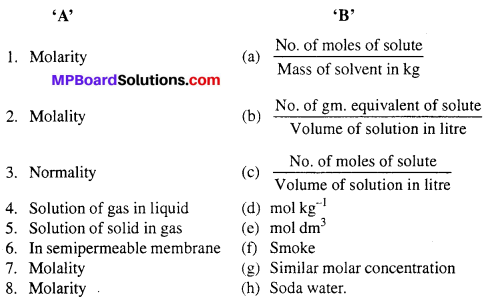
Answers:
- (c)
- (a)
- (b)
- (h)
- (f)
- (g)
- (d)
- (e).
Question 4.
Answer in one word / sentence :
1. Write the formula to determine normality.
2. What is the unit of molality ?
3. Write the formula which states the relation between relative lowering in vapour pres¬sure and mass of solute.
4. What is the property of a dilute solution which depend on the number of solute present in it ?
5. What is Raoult’s law ?
6. Give an example of non-ideal solution showing positive deviation.
7. Give an example of non-ideal solution showing negative deviation.
8. Give an example of antifreeze compound.
9. Write the unit of representing pollution.
10. Write the example of minimum boiling constant solution.
Answers:
1.
![]()
2. Mole per kilogram,
3. \(\frac{P_{A}^{0}-P_{A}}{P_{A}^{\circ}}=\frac{W_{B}}{M_{B}} \times \frac{M_{A}}{W_{A}}\)
4. Colligative properties
5. At a definite tempearture for a solution of a non-volatile solute relative lowering in vapour pressure is equal to the mole fraction of solute
6. CH3COCH3 + C6H6
7. CHCl3 + CH3COCH3
8. Ethylene glycol
9. ppm
10. 96.4% C2H5OH + 4.5% H2O.
Solutions Very Short Answer Type Questions
Question 1.
Write formula of van’t Hoff factor T.
Answer:
![]()
Question 2.
Write down van’t Hoff equation. Give formula used for calculating molecular mass with its help.
Answer:
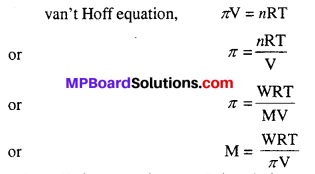
Where, W is mass of solute, R is solution constant, T is temperature, n is osmotic pressure and V is volume of solution.
Question 3.
6.3 gm oxalic acid (Eqv. wt 63) is dissolved in 500 ml of solution. Find out the normality of solution.
Solution:

Question 4.
Define formality and write its formula.
Answer:
Formality is defined as number of gram formula mass of substance dissolved in a litre of solvent. It is denoted by F. It is used for solutions in which solute associates.
![]()
Question 5.
Determine the molarity of a solution of 4#0 gram per litre concentration of NaOH.
Solution:

Question 6.
Give two-two example of solution showing negative deviation.
Answer:
(i) CHCl3 + CH3COCH3
(ii) CHCl3 + C2H5OC2H5.
Question 7.
Give two examples of non-ideal solutions showing positive deviation.
Answer:
Examples of non-ideal solutions showing positive deviation are :
(i) CCl4 and CHCl3
(ii) CCl4 and C6H5CH3 (Toluene).
Question 8.
Define Normality.
Answer:
Number of gram equivalent of solute present in one litre of solution is called normality. It is represented by N.

Normality of a solution changes with temperature as it is based on mass-volume relationship and volume changes with change in temperature.
Question 9.
If 2 gm NaOH is present in 250 ml solution, then determine the normality of the solution.
Solution:
Equivalent mass of sodium hydroxide (NaOH) = 40
Amount dissolved in 250 ml NaOH solution = 2 gm
∴ 1000 ml solution of NaOH contains

Question 10.
Differentiate between Molarity and Molality.
Answer:
Differences between Molarity and Molality :
Molarity (M)
- Molarity involves the total volume of solution.
- In molarity, gram moles of solute are dissolved in 1 litre of solution.
- Molarity changes with temperature because volume changes with tempe-rature.
Molality (m)
- Molality involves the mass of solvent.
- In molality, gram moles of solute are dissolved in 1 kg of solvent. Here volume of solution is not considered.
- Molality is independent of temperature as it takes mass into consideration.
Question 11.
Explain the following term : Parts per million.
Answer:
(i) Parts per million : When a solute is present in very minute amounts (in traces), the concentration is expressed in parts per million abbreviated as ppm. The parts may be of mass or volume. It is the parts of a component per million parts of the solution.

Where, ppm. is the concentration of component A in parts per million.
Question 12.
Write two examples of non-ideal solution showing negative deviation.
Answer:
- Chloroform and acetone
- Water and hydrochloric acid.
Question 13.
On which factor colligative properties of a solution depend ?
Answer:
Number of solute particles.
Question 14.
What is transition temperature ?
Answer:
The temperature at which the nature of solubility changes (i. e„ first it increases, then decreases) is known as transition temperature. Solubility of sodium sulphate in water , increases upto 324, then it starts decreasing. Thus, 324°C is the transition temperature of sodium sulphate.
Question 15.
Give an example of such a solid solution in which solute is a gas.
Answer:
Hydrogen (solute) in Palladium (solvent).
Question 16.
Sprinkling of salt help in clearing the snow covered roads in hilly areas. Why?
Answer:
On sprinkling salts like CaCl2 or NaCl over snow covered roads, the freezing point of water lowers to such an extent that water does not freeze to form ice and as a result the snow starts melting from the surface and therefore it helps in clearing the roads.
![]()
Solutions Short Answer Type Questions
Question 1.
Write down Raoult’s law.
Answer:
The vapour pressure of a solution containing non-volatile solute is directly proportional to the mole fraction of the solute,
Mathematically,

Where, P°A = Vapour pressure of pure solvent, PA = Vapour pressure of solvent in solution, XB = Mole fraction of solute.
Question 2.
What is Azeotropic mixture ? They are of how many types ?
Ans.
Azeotropic mixture is the mixture of liquids which boil at one temperature with- out any change in composition. For example, at the composition of 95-6% alcohol and 4 4% water. It form an azeotropic mixture which boils at 78.13°C. Components of this mixture cannot be separated fully by fractional distillation.
They are of two types :
(1) Low boiling azeotropic mixture: Such solutions which represent positive deviation towards Raoult’s law i.e. their vapour pressure is high thus their boiling point is low are known as low boiling azeotropic mixture.
Example : (i) CS2 + Acetone, (ii) C2H5OH + n-hexane.
(2) High boiling azeotropic mixture : Such solutions which represent negative deviation towards Raoult’s law i.e. their vapour pressure is low thus their boiling point is high are known as high boiling azeotropic mixture,
Example : (i) Acetone + Chloroform, (ii) Ether + Chloroform.
Question. 3.
Give relation between elevation in boiling point and molecular mass of solute.
Answer:
Relation between elevation in boiling point and molecular mass of solute :
Suppose, WB gram of non-volatile solute dissolve in WA gram of solvent and the mollecular mass of non-volatile solute is MB gram. Then, molality, m will be


Question 4.
Derive the expression for molecular mass of solute by relative lowering in vapour pressure.
Answer:
Determination of molecular mass of solute by relative lowering in vapour pressure : Suppose a known mass(WB)of solute is dissolved in known mass (WA) of solvent to give a dilute solution and the relative lowering of vapour pressure of the solution is equal to mole fraction of solute.

It is determined by experiment, when the molecular mass of solvent (MA) is known, the molecular mass of the solute (MB) can be calculated as given below :
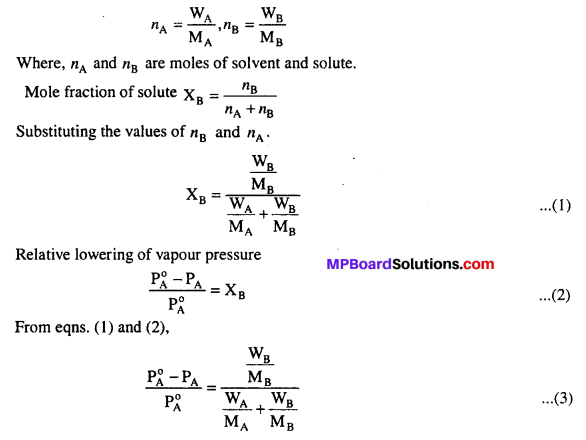


If relative lowering of vapour pressure \(\left[\frac{P_{A}^{0}-P_{A}}{P_{A}^{0}}\right]\) is known and WA,WB,MA are also known then molecular mass of solute MB can be calculated from the eqn. (5).
Question 5.
What are ideal and non-ideal solutions ? Explain with example.
Answer:
Ideal solutions: Ideal solutions are those solutions in which Raoult’s law can be applied completely for all concentrations of the solutions and at all temperatures.
Condition for ideal solutions are following :

Non-ideal solutions: Solutions in which Raoult’s law cannot be applied completely for all concentrations and temperatures are called non-ideal solutions.
For these solutions:

Question 6.
Differentiate between Diffusion and Osmosis.
Answer:
Differences between Diffusion and Osmosis :
Diffusion:
- Molecules move from a region of high concentration to lower concentration.
- Semipermeable membrane is not required.
- This process takes place in gases and in liquids.
- Molecule of both solute and solvent move.
- It cannot be stopped by applying pressure from opposite direction.
Osmosis:
- Molecules of solvent move from solution of low concentration to solution of high concentration.
- Semipermeable membrane is required.
- This process takes place only in solution.
- Only molecules of solvent move.
- It can be stopped by applying pressure from opposite direction.
Question 7.
Write four examples of colligative properties of solutions.
Answer:
Physical properties of solution which depends upon number of solute particles dissolved in solution, are called colligative properties.
Colligative properties are:
- Lowering of vapour pressure
- Elevation in boiling point
- Depression in freezing point
- Osmotic pressure.
Value of ail colligative properties increases with increase in concentration of solute and decreases with decrease in concentration.
Question 8.
Establish van’t Hoff solution equation.
Answer:
Osmotic pressure of dilute solution of a non-volatile solute is proportional to absolute temperature of the solution at constant concentration. This is known as van’t Hoff law.
π α T
Derivation : Osmotic pressure n of a solution is directly proportional to a molar concentration.

Question 9.
Define the following :
(i) Molal elevation boiling point constant
(ii) Molal freezing point depression constant.
Answer:
(i) Molal elevation boiling point constant: Molal elevation constant can be defined as ‘The elevation in boiling point of the solution in which 1 gm of solute is dissolved in 1000 gm of solvent.”
∴ Elevation in boiling point

Where Kb = Molal boiling point elevation constant
(ii) Molal freezing point depression constant: Molal depression constant may be defined as “The depression in freezing point for 1 molal solution i. e., solution in which 1 gm mole of solute is dissolved in 1000 gm of solvent.”
∴ Depression in freezing point

Question 10.
(a) What is osmotic pressure ?
(b) Solution of urea is prepared by dissolving 6 gm urea in 1 litre. Determine the osmotic pressure of that urea solution at 300 K. (R = 0.0821 L atom K-1 mol-1) (Mo-lecular mass of urea = 60)
Answer:
(a) Osmotic Pressure: Osmotic pressure is the excess hydrostatic pressure that builds up when the solution is separated from the solvent by a semipermeable membrane. It is denoted by π.
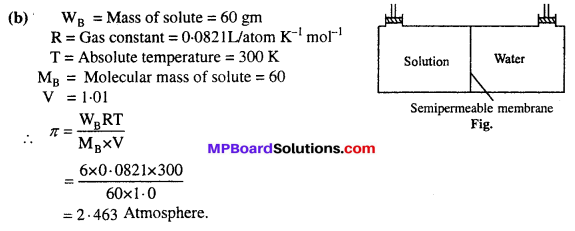
Solutions Long Answer Type Questions
Question 1.
What are constant boiling mixture ? Write three differences in Ideal solution and Non-ideal solution.
Answer:
Constant boiling mixtures or azeotropic mixture. A solution which distils without change in composition is called azeotropic mixture.
Differences between Ideal and Non-ideal solution
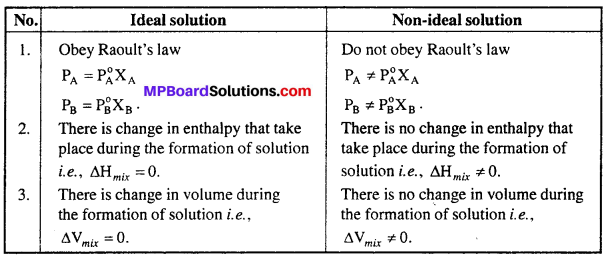
Question 2.
(a) What is meant by depression in freezing point ?
(b) Solution is prepared by dissolving 1 gm NaCl in 100 gm water. If molal de-pression constant for water is 1-85 K kg mol-1 then determine the extent of dissociation of NaCl. Depression in freezing point for NaCl solution is 0-604 K.
Answer:
(a) Freezing point of a substance is the temperature at which its solid and liquid phases have the same vapour pressure. If non-volatile solute is dissolved in pure liquid to constitute a solution its freezing point decreases, this decrease in freezing point is called depression of freezing point and it is denoted by ∆Tf.
(b) Observed molecular mass of NaCl can be calculated by the following formula:

Thus, observed molecular mass = 30.6 and normal molecular mass of sodium chloride = 58.5.
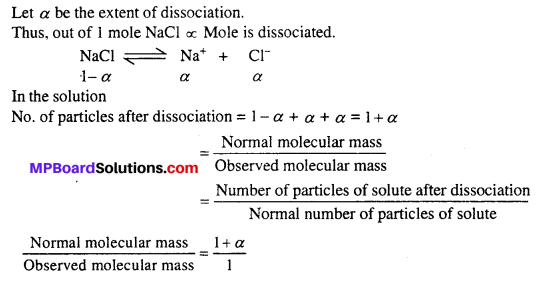
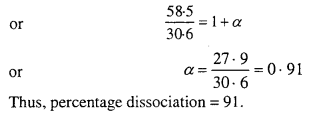
Question 3.
Write five differences in solution having Positive deviation and Negative deviation.
Answer:
Differences between Positive deviation and Negative deviation :
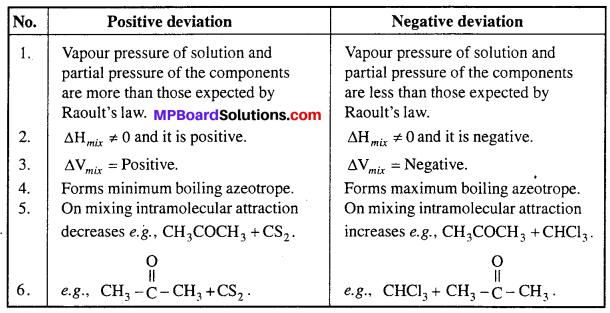
Question 4.
Explain in brief Berkeley and Hartley’s method of osmotic pressure measurement and state its uses.
Answer:
Berkeley and Hartley’s method : In this method, pressure is applied over the solution to stop the flow of solvent. This pressure is equivalent to osmotic pressure.
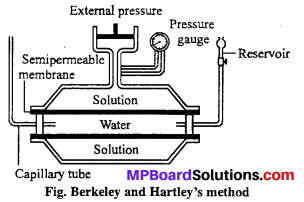
In this method, the apparatus consists of a strong vessel made up of steel in which porous pot is fitted. In the porous pot, copper ferro-cyanide semipermeable membrane is deposited. The porous pot is fitted with a capillary tube on one side and a water reservoir on the other side. A piston and pressure gauge are fitted to the steel vessel.
The porous pot and steel vessel are filled with water and solution respectively. Osmosis takes place and water moves into the steel vessel from the porous pot through the semipermeable membrane. This is shown by fall in water level in the capillary tube. This flow of water is stopped by applying external pressure on the solution with the help of piston.
This method has the following advantages :
- It takes comparatively lesser time to determine osmotic pressure.
- Concentration of solution does not change, hence better results are obtained.
- As high pressure is not exerted over semipermeable membrane, it does not break.
- High osmotic pressure can be measured.
Question 5.
(a) What is molal elevation boiling point constant ?
(b) On dissolving phenol in benzene, two of its molecule associate to form a bigger molecules. When Z gm phenol is dissolved in 100 gm benzene, then its freezing point decreases by 0.69°C. Determine the extent of association of phenol. (Kf = 512 K kg mol-1).
Answer:
(a) Molal boiling elevation constant: It is defined as the elevation in boiling point when 1 gm of non-volatile solute is dissolved in 1000 gm of the solvent.
We know that, ∆Tb α m or ∆Tb = Kbm
Where, Kb is a molal elevation boiling point constant.
Elevation in boiling point is directly proportional to molality of the solution.
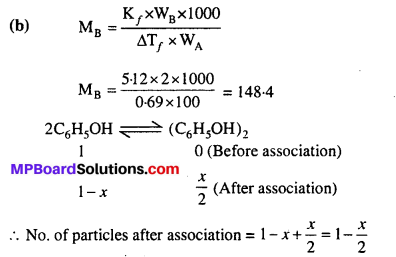
Normal molecular mass of phenol = 6 × 12 + 1 × 5 + 16 + 1 = 94
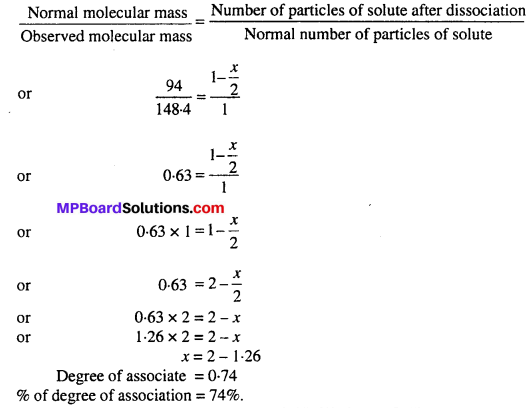
Question 6.
What do you understand by van’t Hoff’s factor ? Write its importance.
Answer:
van’t Hoff’s factor (i) : This factor expresses the extent of association or dissociation of solutes in solution. It is defined as the ratio of the observed value of colligative property to the theoretical value of colligative property, i.e
![]()
If association of solute in solution takes place, number of particles decreases. Whereas, in case of dissociation number of particles increases. Since, colligative property depends upon the actual number of particles in solution and is inversely proportional to molecular mass, thus, observed value may be more or less due to association or dissociation.
After introducing the van’t Hoff’s factor (i), the modified equations for colligative properties may be written as :

From the value of ‘i’ degree of dissociation or degree of association of a solute can be calculated.
Value of i : (i) If it is l, then it represents neither association nor dissociation.
(ii) If value of i is less than l, then it expresses association, e.g., solution of benzoic acid in benzene.
(iii) If it is more than 1, then dissociation takes place, e.g., solution of NaCl in water.
![]()
Assuming no association or dissociation.
Question 7.
Molecular weight obtained on the basis of colligative property is sometimes different from the actual molecular weight Explain.
Answer:
When value of observed molar mass for a solution is more or less than values of normal molar mass.Then they are known as abnormal molar mass. Abnormal molar mass primarily due to :
(1) Association of solute molecule and (2) Dissociation of solute molecule.
(1) Association of solute molecule: This leads to decrease in the number of molecular particles on dissolving in a solvent. Due to association, there is decrease in the values of colligative properties. Hence, higher values are obtained for the molecular mass of solutes compound to the normal values.
Example : When acetic acid is dissolved in benzene it shows a molecular mass of 120. While the normal molecular mass is 60, these are due to dimer formation as a result of hydrogen bonding.

(2) Dissociation of solute molecules : In electrolytic solution molecules of electro-lytes dissociate to give two or more particles. Since the number of solute particles in solution of such substance is more than the expected value, these solution give higher value of colligative properties. The value of colligative properties are inversely proportional to mo-lecular masses, so the calculated values of molecular mass will be less than normal values.
Example: KCl dissociates into K+ and Cl– ions when dissolved in water so the number of solute particles in solution would be double, the number of particle if no dissociation had been take place. So on the basis of colligative properties the expected value of molecular
mass is half of its normal molecular mass i.e. = \(\frac { 74.5 }{ 2 } \) = 37.25
Question 8.
An aqueous solution freezes at – 0.385°C
if Kf= 3.85 K kg/mol, Kb = 0.712 K kg/mol
Then, determine the elevation in its boiling point.
Solution:
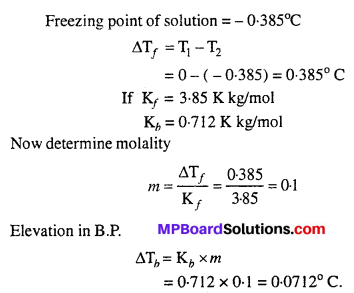
Question 9.
What is elevation in boiling points ? How addition of a non-volatile solute elevates the boiling point of a solvent ? Explain it with the help of graph diagram.
Answer:
The vapour pressure of the solution containing a non-volatile solute is always less than that of pure solvent. Therefore, the solution has to be heated to higher temperature so that its vapour pressure become equal to the atmospheric pressure. Thus, the boiling point of solution (Tb) is always higher than the boiling point of solvent (Tb°). The difference Tb – Tb° is called elevation in boiling point.
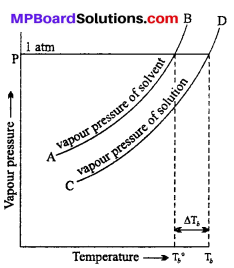
If we plot graph between temperature and vapour pressure of a pure solvent and its solution, then following curve is obtained. Curve AB gives the vapour pressure for the pure solvent and the curve CD gives the vapour pressure of the solution at different temperature.
At temperature Tb° the vapour pressure of the solvent becomes equal to the atmospheric pressure hence it boils at Tb°. Now, by the addition of non-volatile solute, lowering of vapour pressure of the solution takes place. And to increase the vapour pressure of the solution to become equal to atmospheric pressure, the temperature rises. Hence, at Tb the solution boils. Thus, the boiling point is now elevated from Tb° to Tb. The rise in temperature that results by the addition of a non-volatile solute in a solvent is termed as elevation in boiling point. It is represented by ∆Tb.
So, elevation in boiling point (∆Tb) = Tb – Tb°.
Question 10.
Prove that the relative lowering in vapour pressure of a solution is equal to mole fraction of solute present in the solution.
Or, What is Raoult’s law ? Establish its mathematical expression.
Or, What is Raoult’s law ? How can molar mass of a non-volatile solute be deter-mined with its help ?
Answer:
Raoult’s law : For a solution in which solute is non-volatile, the Raoult’s law- may be stated as following :
“At any constant temperature, vapour pressure of solvent collected above the solution of non-volatile solute, is directly proportional to the mole fraction of solute.”
If a non-volatile solute is added to a volatile solvent, the vapour pressure of the solvent decreases. The vapour pressure of the solvent is directly proportional to its mole fraction. As the solute is non-volatile, the vapour pressure of the solution (P) will be equal to the vapour pressure of the solvent (PA).
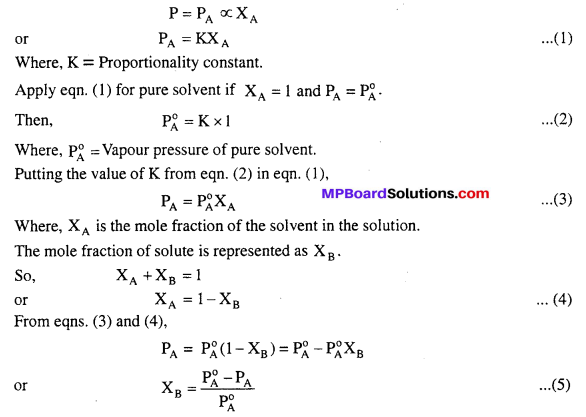
P°A – PA is lowering in vapour pressure and \(\frac{\mathrm{P}_{\mathrm{A}}^{\mathrm{o}}-\mathrm{P}_{\mathrm{A}}}{\mathrm{P}_{\mathrm{A}}^{\mathrm{o}}}\) is relative lowering in vapour pressure.
On the basis of equation (5) Raoult’s law can be defined as “The relative lowering in vapour pressure of a solution containing non-volatile solute is equal to mole fraction of solute”.
Question 11.
What is molal freezing point depression constant ? Derive the formula to establish relation between molal freezing point depression constant and molecular mass of solute.
Or,
What is molal freezing point depression constant ? Show that depression in freezing point is a colligative property. How can molecular mass of solute be deter-mined from depression in freezing point ?
Answer:
Molal freezing point depression constant is equal to depression in freezing point of the solution when 1 gm mole is dissolved in 1000 gm of solvent. It is represented by Ky i.e.,

Thus, depression in freezing point is proportional to molality of solution. Molality is directly proportional to number or molecules of solute substrance. Therefore, depression in freezing point is a colligative property.
Calculation of molecular mass of solute : By determination of depression in freez-ing point, the Molecular mass of non-volatile solute can be determined.
For a solution of non-volatile solute,
∆Tf = Kf × m ….(1)
Let WB gram non-volatile solute is dissolved in WA gram solvent and molecular mass of solute is MB.
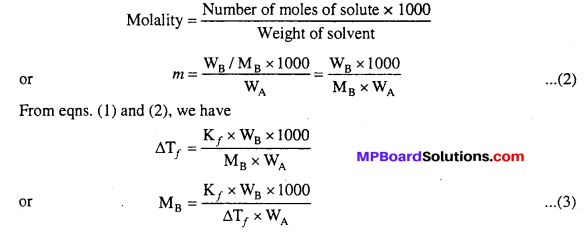
From eqn. (3), molecular mass of solute (MB) can be calculated.
![]()
Solutions Numerical Questions
Question 1.
1.325 gram sodium carbonate is dissolved in 250 ml solution. Determine the concentration of solution in gram/litre.
Solution:
![]()
Mass of Na2CO3 = 1.325 gram
Volume of solution = 250 gram
Concentration of sodium carbonate in gram per litre \(\frac { 1.325 }{ 250 } \) × 1000 = 5.3.
Question 2.
4 gm caustic soda (NaOH) is dissolved in 500 ml aqueous solution. Deter-mine the normality of the solution.
Solution:
∵ In 500 ml. solution 4 gm NaOH is dissolved
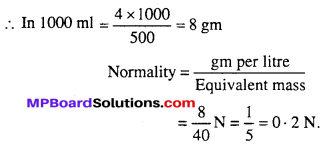
Question 3.
Determine the osmotic pressure of 5% glucose solution at 25°C. Molecular mass of glucose = 180, R = 0-0821 litre atmosphere.
Solution:
∵ 5 gm glucose is dissolved in 100 ml.
∴ 180 gm glucose will be dissolved in \(\frac { 100 }{ 5 } \) × 180
= 3600 ml = 3.6 litre
We know that,

Question 4.
12.5 gm of urea dissolved in 170 gm of water. The elevation in boiling point was found to be 0.63 K. If Kb for water = 0.52 Km-1, calculate the molecular mass of urea.
Solution:
